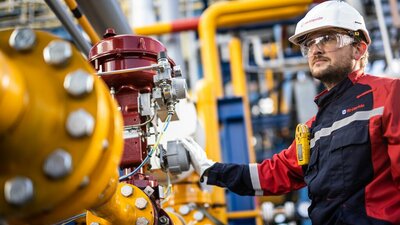Hydrogen, a solution to accelerate the decarbonization of freight transport
Published on March 15, 2024
7 minutes

Road freight transport accounts for a quarter of all mobility-related CO2 emissions. Faced with this challenge, European Union member states have tightened the rules on carbon emission reductions for new heavy goods vehicles entering the market. The goal? A 45% reduction by 2030 and a 90% reduction by 2040 (compared with 2019 levels). To achieve these highly ambitious targets, hydrogen will have to become an indispensable part of the energy mix. Thierry Carbonnel, Marketing Director for Heavy Duty Mobility, Air Liquide, delves into the key challenges facing the sector.
What role does hydrogen currently play when it comes to road transport?
It might seem like the era of hydrogen-powered road transport is still in its infancy, but that's not quite true! Several thousand hydrogen-powered trucks and buses already ply the roads in China. In Europe, the growth of hydrogen mobility began with intensively-used professional fleets of passenger cars. The example that immediately springs to mind are the HysetCo taxis in the Paris region. It demonstrated the reliability of hydrogen vehicles, while popularizing the benefits of hydrogen. On the road, hydrogen translates to less noise, a real driving comfort, and water vapor being the only exhaust emission.
If we turn our attention to the world's leading truck manufacturers, they are all aware of the deadlines that lie ahead. They all have at least one hydrogen truck project, completed or ongoing. They came in various shapes and forms: prototypes, pre-series ranges or even final mass-produced vehicles! Daimler Truck, for instance, is testing two prototypes equipped with fuel cells, one running on gaseous hydrogen, the other on liquid hydrogen. IVECO will deliver its first series production vehicles in 2024 as part of the HyAMMED project. There's also Hyundai, a new player in the sector, which has deployed its first hydrogen trucks in Switzerland and the United States.
What are the different technologies used in hydrogen-powered trucks?
When it comes to powertrains, there are two complementary options. Several manufacturers are exploring them head-on to support the transition period. In the first option, in simple terms, fuel cell electric vehicles (FCEVs) convert the hydrogen stored on board into electricity and then work like electric vehicles. Trucks currently being developed benefit directly from all the advances made in FC technology (notably cost reduction and energy efficiency).
The other way is the internal combustion engine (ICE). Here, hydrogen gas is injected to replace diesel. This is known as "retrofitting". It implies a limited impact on vehicle design and maintenance, since diesel engines have been around for over 130 years, and the technology has been tried and tested by manufacturers, garages, and truck drivers. While ICE generates fine particles and NOx, albeit in much smaller quantities than diesel, mature technologies for capturing these exhaust emissions do exist.
The bottom line is that, in the space of just a few years, truck manufacturers have positioned themselves remarkably to respond to the climate emergency and the new regulations. When you consider the classic truck product development cycle, this is quite astonishing.
What are the main advantages of hydrogen from a transport operator’s point of view?
For transport operators, there are three obvious advantages. They are particularly important, as they affect the drivers' work rhythm and therefore the fluidity of operations. First, there's the refueling time. Hydrogen makes it possible to fill up in 15 to 20 minutes. This is close to the time required to fill up with diesel and thus has little to no impact on logistics or scheduling. Then there's range. The same tank of fuel can cover 800 to 900 km. This can be extended to 1,000 km with liquid hydrogen, as Daimler Truck demonstrated in 2023. For a driver, that's some peace of mind! Finally, there's the payload, which hydrogen technology doesn't impact, since 70 to 80 kg of on-board hydrogen is enough, without the need for batteries, which reduces the volume and weight that trucks can carry. All in all, hydrogen is particularly well-suited to long-distance transport, providing flexibility and productivity. It is a good complement to electric vehicles, which are relevant for planned, short-distance routes.
There remains the question of the cost of transitioning to hydrogen…
Naturally, all players are mindful of the costs of hydrogen mobility, from the price of the vehicles to the price of hydrogen at the filling station. A model shared by several major European automakers predicts hydrogen/diesel parity by 2030. Factors favoring hydrogen include a gradual drop in the price per kilo of the molecule, lower truck manufacturing and maintenance costs and tax incentives. At the same time, we're likely to see an increase in taxation, both on diesel and on the Eurovignette road tax. The gradual transition of fleets will therefore depend on the implementation of appropriate and, I would say, ambitious public policy measures!
What are Air Liquide's strengths in meeting the challenge of decarbonizing road transport?
Well, that’s an easy question to answer! We cover the entire hydrogen value chain. Air Liquide's core business focuses on production, storage, conditioning, and distribution. So, it's on these levers that we act first and foremost. When it comes to production, there's no secret: we need to produce a growing share of low-carbon or renewable hydrogen. Otherwise, we won't be able to meet the challenge of decarbonizing transport. Major investments have been made, such as our 200 MW Air Liquide Normand'Hy electrolyzer, due to come on stream in 2026. In other words, 200 MW translates to 28,000 tons of hydrogen produced in one year, a part of which will supply the mobility sector. What's more, mass production will help to bring the cost of low-carbon hydrogen down to a competitive level more quickly. This is also why we are working on a number of technological building blocks. Competitiveness, safety, reliability and lower TCO are our priorities.
How does Air Liquide intend to support players in the transport sector in their transition to hydrogen?
The decarbonization of road transport is a collective enterprise. With this in mind, we have developed a number of partnerships and projects that enable us to better understand and provide solutions to the problems faced by all the major players in the sector: automakers, equipment manufacturers, fleet operators, etc. Our support focuses on technologies. This is the case, for example, with FORVIA (Faurecia), with whom we are working to develop the liquid hydrogen tanks of tomorrow. We also help our customers to find the subsidies they need to make the transition to hydrogen. Funding can be obtained from various bodies: the European Union, governments, regions, etc. Customers who would like to test hydrogen right now and evaluate available technologies should know that it's possible, and that we're here to help.
In January 2024, Air Liquide and TotalEnergies created a 50/50 joint venture named TEAL Mobility. What does it entail?
TEAL Mobility intends to accelerate the development of hydrogen for long-haul trucks by developing a network of over 100 hydrogen filling stations across Europe over the next 10 years. These stations, operated under the TotalEnergies brand, will be located on Europe’s main highway lines, and will contribute to the continent-wide alternative fuels infrastructure (AFIR) network called for by the AFIR regulation adopted by the European Council in 2023. The aim is to have a hydrogen station every 200 km by 2030. TEAL Mobility supports this ambition and solves the chicken-and-egg paradox of what comes first, trucks or infrastructure. To convince truck manufacturers to bring hydrogen-powered models to market quickly, and for operators to integrate them into their fleets, we need a sufficiently large number of fueling stations with suitable capacities (from 1 tonne per day). As we have seen, this is not the only factor, but it will play a decisive role in the transition to hydrogen.
1. The Eurovignette is a road user charge. Heavy goods vehicles with a gross vehicle weight of minimum 12 tons have to buy the Eurovignette to use motorways in participating European Union countries.





